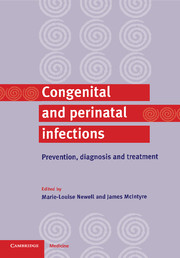Book contents
- Frontmatter
- Contents
- List of contributors
- Preface
- Part I General issues
- Part II Specific infections
- 5 Rubella infection in pregnancy
- 6 Perinatal Group B streptococcal infections
- 7 Mother-to-child transmission of cytomegalovirus
- 8 Varicella
- 9 Herpes simplex
- 10 Vertical transmission of hepatitis viruses
- 11 Papillomavirus infections as a perinatal problem: diagnosis, prevention and management
- 12 HIV-1 infection
- 13 Syphilis: prevention, diagnosis and management during pregnancy and infancy
- 14 The other sexually transmitted diseases
- 15 Toxoplasmosis
- 16 Neonatal sepsis
- Index
10 - Vertical transmission of hepatitis viruses
Published online by Cambridge University Press: 06 July 2010
- Frontmatter
- Contents
- List of contributors
- Preface
- Part I General issues
- Part II Specific infections
- 5 Rubella infection in pregnancy
- 6 Perinatal Group B streptococcal infections
- 7 Mother-to-child transmission of cytomegalovirus
- 8 Varicella
- 9 Herpes simplex
- 10 Vertical transmission of hepatitis viruses
- 11 Papillomavirus infections as a perinatal problem: diagnosis, prevention and management
- 12 HIV-1 infection
- 13 Syphilis: prevention, diagnosis and management during pregnancy and infancy
- 14 The other sexually transmitted diseases
- 15 Toxoplasmosis
- 16 Neonatal sepsis
- Index
Summary
Introduction
Hepatitis is a general term for inflammation of the liver due to a variety of causes, of which viruses are the most common, but which can also include toxic and auto-immune disorders. The consequences of liver disease in pregnancy, including maternal and fetal outcome, are beyond the scope of this chapter, which focuses on vertical transmission. Acute hepatitis in the mother must be distinguished from other types of liver disease, either unique to pregnancy, such as cholestasis of pregnancy, acute fatty liver of pregnancy and preeclampsia / HELLP syndrome, or pre-existing liver disease, such as cholelithiasis. Although a number of viruses, including herpes simplex and cytomegalovirus, can cause hepatitis, viral hepatitis refers to infections caused by the hepatitis viruses.
Six distinct hepatitis viruses are known: A, B, C, D, E and G, which are not easily distinguished on clinical grounds. Hepatitis A and E are transmitted by the faecal-oral route, and are not commonly transmitted vertically. However, they can cause either asymptomatic infection or fulminating acute hepatitis, notably for HEV in pregnant women. HBV, HCV, HDV and HGV are bloodborne agents, which can lead to chronic carriage, and subsequently to mother-to-child transmission. The clinical significance of HGV remains undetermined, and HDV is dependent upon co-infection with HBV for replication. Hence, HBV and HCV are the most important. They have similar epidemiological and clinical features, and in both infections, asymptomatic carrier mothers can be identified only if serologic testing is performed. Yet there are also important differences. HBV has been known for decades, has a high risk of mother-to-child transmission, with potentially serious long-term consequences for the child, but which can be effectively prevented with immune prophylaxis.
- Type
- Chapter
- Information
- Congenital and Perinatal InfectionsPrevention, Diagnosis and Treatment, pp. 164 - 204Publisher: Cambridge University PressPrint publication year: 2000
- 2
- Cited by



